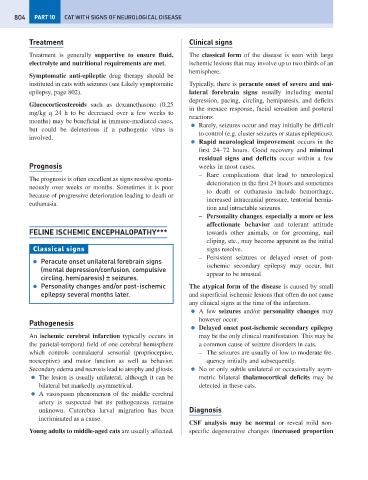Page 812 - Problem-Based Feline Medicine
P. 812
804 PART 10 CAT WITH SIGNS OF NEUROLOGICAL DISEASE
Treatment Clinical signs
Treatment is generally supportive to ensure fluid, The classical form of the disease is seen with large
electrolyte and nutritional requirements are met. ischemic lesions that may involve up to two thirds of an
hemisphere.
Symptomatic anti-epileptic drug therapy should be
instituted in cats with seizures (see Likely symptomatic Typically, there is peracute onset of severe and uni-
epilepsy, page 802). lateral forebrain signs usually including mental
depression, pacing, circling, hemiparesis, and deficits
Glucocorticosteroids such as dexamethasone (0.25
in the menace response, facial sensation and postural
mg/kg q 24 h to be decreased over a few weeks to
reactions.
months) may be beneficial in immune-mediated cases,
● Rarely, seizures occur and may initially be difficult
but could be deleterious if a pathogenic virus is
to control (e.g. cluster seizures or status epilepticus).
involved.
● Rapid neurological improvement occurs in the
first 24–72 hours. Good recovery and minimal
residual signs and deficits occur within a few
Prognosis weeks in most cases.
– Rare complications that lead to neurological
The prognosis is often excellent as signs resolve sponta-
deterioration in the first 24 hours and sometimes
neously over weeks or months. Sometimes it is poor
to death or euthanasia include hemorrhage,
because of progressive deterioration leading to death or
increased intracranial pressure, tentorial hernia-
euthanasia.
tion and intractable seizures.
– Personality changes, especially a more or less
affectionate behavior and tolerant attitude
FELINE ISCHEMIC ENCEPHALOPATHY*** towards other animals, or for grooming, nail
cliping, etc., may become apparent as the initial
Classical signs signs resolve.
– Persistent seizures or delayed onset of post-
● Peracute onset unilateral forebrain signs
ischemic secondary epilepsy may occur, but
(mental depression/confusion, compulsive
appear to be unusual.
circling, hemiparesis) ± seizures.
● Personality changes and/or post-ischemic The atypical form of the disease is caused by small
epilepsy several months later. and superficial ischemic lesions that often do not cause
any clinical signs at the time of the infarction.
● A few seizures and/or personality changes may
however occur.
Pathogenesis
● Delayed onset post-ischemic secondary epilepsy
An ischemic cerebral infarction typically occurs in may be the only clinical manifestation. This may be
the parietal-temporal field of one cerebral hemisphere a common cause of seizure disorders in cats.
which controls contralateral sensorial (proprioceptive, – The seizures are usually of low to moderate fre-
nociceptive) and motor function as well as behavior. quency initially and subsequently.
Secondary edema and necrosis lead to atrophy and gliosis. ● No or only subtle unilateral or occasionally asym-
● The lesion is usually unilateral, although it can be metric bilateral thalamocortical deficits may be
bilateral but markedly asymmetrical. detected in these cats.
● A vasospasm phenomenon of the middle cerebral
artery is suspected but its pathogenesis remains
unknown. Cuterebra larval migration has been Diagnosis
incriminated as a cause.
CSF analysis may be normal or reveal mild non-
Young adults to middle-aged cats are usually affected. specific degenerative changes (increased proportion

